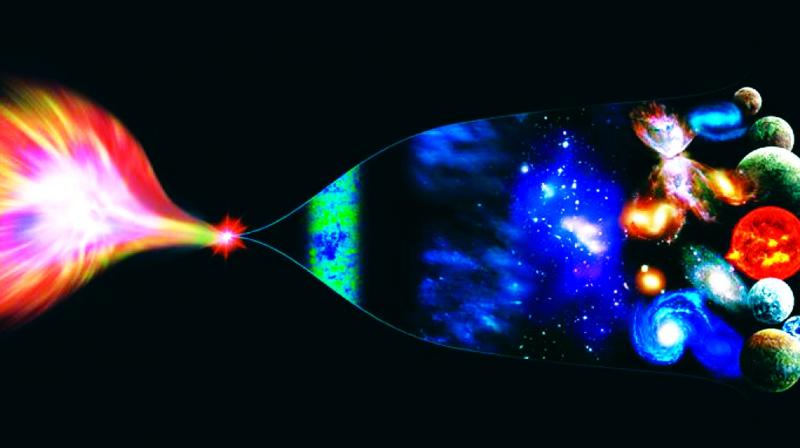The origin of the universe called into question

Hyderabad: The universe possibly did not begin with a Big Bang or a big bounce, but rather as a result of the condensation of atoms in space.
The Rising Universe existed before our own universe was formed, in an alien world where time, space and geometry were not shaped.
The Big Bang happened with the general relativity theory, where space and time are unified as space-time.
This space-time canvas was converted to discrete threads called ‘atoms of space’.
In the same way that steam converts to water upon condensation, likewise the atoms of space have condensed to become the universe, says a theorist.
The key analogy used is fluids, which exist only in the liquid form because the underlying atoms can only organise themselves in that state.
Even though the molecules are H2O (hydrogen and oxygen) for both steam and liquid water, the way the underlying atoms are organised is what determines the state it takes.
Likewise, the possibility that what happens at the start of the universe is that the universe becomes so hot, dense, curved, “extreme” and that the underlying “atoms” become so “excited” as to cause a change of phase to a new non-geometric phase.
In this phase, the usual notions of space, time and geometry simply do not apply.
Daniele Oriti, a theorist, used a second mathematical framework called group field theory, a version of quantum theory used to describe normal atoms, to explain what happened before the Big Bang.
After almost seven years of pursuit, the theorist at the Max Planck Institute for Gravitational Physics got a first-of-its-kind breakthrough in terms of condensing atoms of space into space-time, which looked like our emerging universe. After more detailed calculations, the output looked like the expanding space-time of our universe.
Mr Oriti told this newspaper, “The usual notions of space, time and geometry have to be reconstructed first in the formalism we worked.
The possibility arises that this ‘reconstruction’ or ‘emergence of space-time’ from non-spatiotemporal entities is only available in one ‘geometric phase’ of the universe, i.e., in one of the many ways in which the fundamental ‘atoms of space’ can organise themselves.”
During this experiment, the theorist noticed that the space-time fluid didn’t like being focussed into a moment, like with the Big Bang, instead, it wanted to bounce back outwards.
“In the very simple situations we studied so far, which also involve very drastic approximations of the underlying formalism, we seem to find both hints that such phase transitions may occur, but also evidence that the universe dynamics can be described in terms of a big bounce.”
, the theorist is apprehensive about this “bounce scenario” due to lack of solid observations because of the various approximations which lead to a prevalence of the “phase transition” scenario.
“We do not know with any certainty, even at the mathematical level, what we should expect, yet.”
“The way forward at the theoretical level is to analyse in more detail the models and see if the phase transition is confirmed mathematically and it replaces the bouncing scenario because the approximations supporting the latter cannot really be trusted at the beginning of the universe.”

